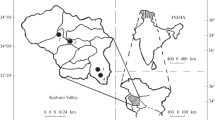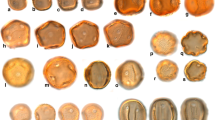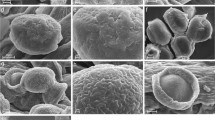Abstract
Several insect- and wind-pollinated species of the genusAcer have been investigated and compared in regard to pollen stickiness. The considerable amount of very inhomogeneous pollenkitt inA. negundo remains on the loculus wall or is deposited inside the exine cavities; thus the pollen is powdery. The small amount of non-homogeneous, granular pollenkitt inA. campestre mostly disappears into the exine cavities; only small droplets appear on the tectum surface; the pollen stickiness therefore is only moderate. On the other hand,A. pseudoplatanus andA. opalus produce an average amount of granular pollenkitt, which is deposited partially inside the exine and partially as a slender film on the tectum surface; in both the pollen is sticky.A. platanoides contains a great deal of granular and homogeneous pollenkitt; it does not only fill up the exine cavities but also extends as a thick, ± homogeneous, non-granular layer of pollenkitt over the tectum surface; therefore, the pollen is very sticky.—The characteristics of pollen agglutination together with other aspects of floral biology illustrate the wide spectrum between unequivocal entomophily and anemophily within the genusAcer: WhileA. negundo is anemophilous andA. platanoides is entomophilous, the remaining species investigated have a pollination syndrome with entomophilous and anemophilous features and are thus amphiphilous. The evolution withinAcer is tending not only towards dioecy, but also towards anemophily.
Similar content being viewed by others
Literatur
Bisboer, D. D., 1975: Pollen morphology of theAceraceae. — Grana15, 19–27.
De Jong, P. C., 1976: Flowering and sex expression inAcer L. (a biosystematic study). — Wageningen 1976.
Gronemeyer, W., 1967: Pollenallergie. In:Hansen, K., Werner, M.: Handbuch der klinischen Allergie, 167–178. — Stuttgart: Thieme.
Haas, Th. P., 1933: Untersuchungen an der GattungAcer. — Dissertation an der Ludwig-Maximilian-Universität München.
Hesse, M., 1978a: Entwicklungsgeschichte und Ultrastruktur des Pollenkitts beiTilia (Tiliaceae). — Pl. Syst. Evol.129, 13–30.
, 1978b: Der Feinbau der Pollenklebstoffe: präparative Probleme bei der Strukturerhaltung, Grundfragen zur Nomenklatur und zur Begriffsabgrenzung. — Linzer Biol. Beiträge9, 181–201.
, 1978c: Entwicklungsgeschichte und Ultrastruktur von Pollenkitt und Exine bei nahe verwandten entomophilen und anemophilen Angiospermensippen:Ranunculaceae, Hamamelidaceae, Platanaceae undFagaceae. — Pl. Syst. Evol.130, 13–42.
- 1978d: Entwicklungsgeschichte und Ultrastruktur von Pollenkitt und Exine bei nahe verwandten entomophilen und anemophilen Angiospermensippen:Salicaceae, Tiliaceae undEricaceae. — Flora (im Druck).
Knoll, F., 1930: Über Pollenkitt und Bestäubungsart. — Z. Botanik23, 610–675.
, 1936: Eine Streuvorrichtung zur Untersuchung der Pollenverkittung. — Österr. Bot. Z.85, 161–182.
Knuth, P., 1898: Handbuch der Blütenbiologie. — Engelmann: Jena.
Pohl, F., 1930: Kittstoffreste auf der Pollenoberfläche windblütiger Pflanzen. Untersuchungen zur Morphologie und Biologie des Pollens II. — Beih. Bot. Cbl. Abt. A,46, 286–305.
Straka, H., 1975: Pollen- und Sporenkunde. Grundbegriffe der modernen Biologie13. — Stuttgart: G. Fischer Verlag.
Svobodová, D., 1977: Morfologická proměnlivost a květní ekologie roduAcer L. — Studie CSAV, Praha, 1–128.
Troll, W., 1928: Über Antherenbau, Pollen und Pollination vonGalanthus L. — Flora123, 321–343.
Wodehouse, R. P., 1935: Pollen grains. — New York: McGraw-Hill.
, 1971: Hayfever plants (2nd revised edition). — Hafner: New York.
Author information
Authors and Affiliations
Additional information
Herrn Prof. Dr.L. Geitler zum 80. Geburtstag gewidmet.
Rights and permissions
About this article
Cite this article
Hesse, M. Ultrastruktur und Verteilung des Pollenkitts in der insekten- und windblütigen GattungAcer (Aceraceae). Pl Syst Evol 131, 277–289 (1979). https://doi.org/10.1007/BF00984259
Received:
Issue Date:
DOI: https://doi.org/10.1007/BF00984259




